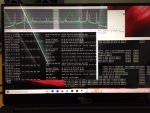I use the RSPdx, so I wouldn't know how to set up things specifically for the RSPduo, but I know it has more capabilities when it comes to trunking.
The "notes" text file in the DSDplus installation folder gives a pretty good rundown. P25 systems are the easiest. All you need to do is navigate to the control channel and set DSDPlus to "combined CC/VC monitor" in the Event Log "control" menu. The software usually figures everything out from there and will begin tracking the frequencies automatically. When it comes to other systems (like NXDN, DMR TIII, Motorola Connect Plus), it can be more involved.
The way I've found works best is to find the signals in whatever SDR software you use, with the waterfall. When you find digital signals that look like DMR, search them on RadioReference. This will usually tell you at least where the signals are coming from, the protocol type, network ID, site number, and frequencies that particular system uses. Sometimes, there will also be a page that lists the frequencies along with their respective channel numbers. This is ideal, since all you have to do from there is find the "DSDPlus.frequencies" file in the DSDplus directory and edit it accordingly using notepad++ (format instructions are at the top of the text in that file). If set up appropriately, you can then run DSDplus/FMPP and it will begin trunk tracking automatically.
More commonly, in my experience, finding the channel numbers is more of a chore. DSDPlus software uses the channel number given from the CC to tune to the appropriate frequency where the action is happening, so if you don't draw that connection in the DSDPlus.frequencies file, the software doesn't know where to go.
In SDRuno, tune to the CC using a 10 mHz wide bandwidth. Port the sound from SDRuno to DSDplus (without FMPP running) using virtual audio cable. Add a VRX in SDRUno and tune it to one of the frequencies found on RadioReference other than the CC, while the first VRX is still tuned on the CC. In the DSDplus Event log window, set it to "Passive Digital Monitor" under the control menu. You should begin to see data flowing and voice channel activity in the Event log window, with channel numbers. Make a list of all the channel numbers you see. Then watch the Event Log while you watch the waterfall on your second VRX in SDRUno. When a signal shows in the waterfall at the same time as the voice call, you have drawn the connection. Each frequency often has two channel numbers associated with it. Do this for each frequency from RadioReference and you will eventually have channel numbers for every frequency. Update DSDPlus.frequencies file with this information, save it, and then run DSDplus with FMPP. If set up correctly, it will begin tracking correctly and you will hear audio for each voice call.
This can be a lot of work the first couple times you do it, and there may be some trial and error, but you'll find you can get most systems figured out. Be happy you have a device that can show a 10mHz bandwidth, because otherwise this method would be nearly impossible.
If you don't want to mess with virtual audio cable and having SDRUno running at the same time, you could just put all the frequencies for a system into the DSDPlus.frequencies file and, once you get your list of channel numbers from the Event Log while tuned to the CC, just enter different channel numbers for each frequency by method of trial and error until you hear voice calls coming through.


